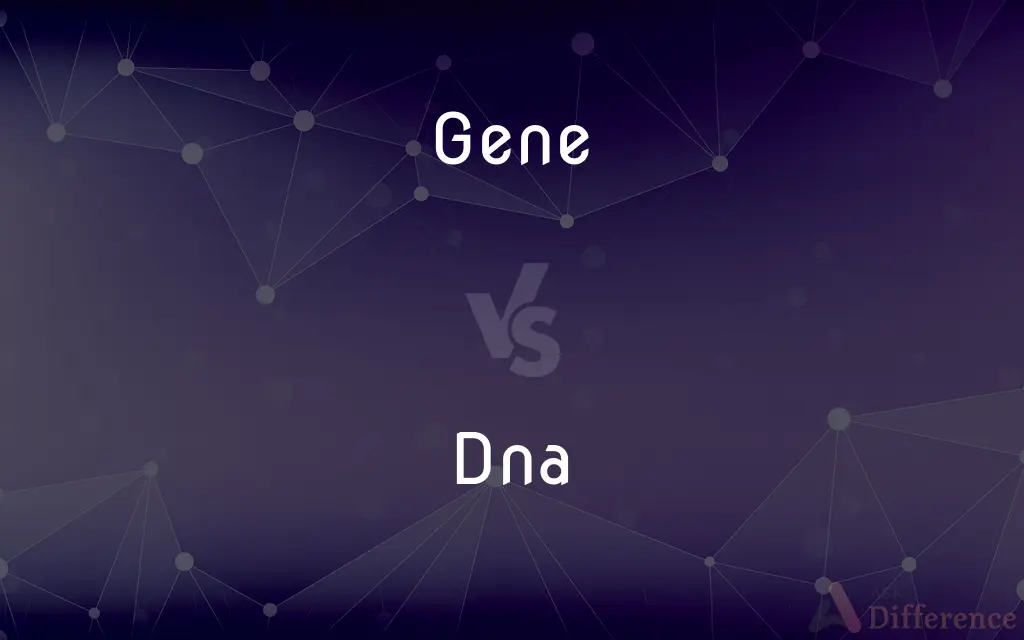Gene vs. Dna — What's the Difference?
By Tayyaba Rehman & Maham Liaqat — Updated on March 20, 2024
A gene is a segment of DNA that codes for a specific protein or function, while DNA is the molecule that contains the entire genetic blueprint of an organism.

Difference Between Gene and Dna
Table of Contents
ADVERTISEMENT
Key Differences
A gene is a specific sequence of nucleotide bases in DNA that carries the information necessary for producing proteins, which are crucial for the body's structure and function. On the other hand, DNA (deoxyribonucleic acid) is a long molecule composed of these nucleotide sequences, serving as the material that carries all the genetic instructions used in growth, development, functioning, and reproduction of living organisms.
Genes are functional units within DNA, determining specific traits or characteristics by encoding for proteins. Whereas DNA is the storage medium that houses thousands of genes, along with regulatory elements that control their expression.
While a gene represents a tiny fraction of the total DNA, focusing on a specific trait or function, DNA encompasses the entire genetic information, structured into chromosomes. DNA's role extends beyond housing genes; it includes regulatory sequences, non-coding regions, and structural components essential for chromosome integrity and function.
The relationship between genes and DNA is analogous to that of chapters to a book. A gene is like a chapter detailing a specific story or instruction, while DNA is the entire book containing all such "chapters" along with the book's structure, such as the table of contents and appendix, which are necessary for its organization and use.
The key difference lies in their scope and function: a gene's purpose is to encode proteins that express specific traits or characteristics, while DNA's purpose is to store and transmit genetic information necessary for the organism's life processes.
ADVERTISEMENT
Comparison Chart
Definition
A segment of DNA coding for a protein or function.
The molecule containing the genetic blueprint of an organism.
Function
Determines specific traits or characteristics by encoding for proteins.
Stores and transmits genetic information necessary for life processes.
Composition
Part of a DNA strand, specific sequence of nucleotides.
Long molecule made up of nucleotides, including many genes.
Role in Genetics
Unit of heredity, responsible for inherited traits.
The medium of genetic information in cells.
Structural Context
A fraction of DNA focused on a specific function.
Entire structure containing genetic information, organized into chromosomes.
Compare with Definitions
Gene
Sequence of DNA that codes for a protein.
The hemoglobin gene codes for the protein that carries oxygen in the blood.
Dna
Composed of four nucleotide bases.
DNA's structure includes adenine, thymine, cytosine, and guanine.
Gene
Determines specific traits.
The gene for eye color determines whether someone has blue, brown, or green eyes.
Dna
Double-helical structure discovered by Watson and Crick.
The double helix of DNA is a key feature of its structure.
Gene
Can be dominant or recessive.
The gene for brown eyes is dominant over the gene for blue eyes.
Dna
Can be damaged by mutations.
DNA damage from UV light can lead to skin cancer.
Gene
Basic physical unit of inheritance.
The BRCA1 gene is associated with a higher risk of chest and ovarian cancer.
Dna
Replicates to pass genetic information to new cells.
DNA replication ensures each new cell has a complete set of genetic information.
Gene
Variants or mutations can affect health.
Mutations in the CFTR gene can lead to cystic fibrosis.
Dna
Carrier of genetic information.
DNA testing can reveal an individual's ancestry.
Gene
In biology, a gene (from genos (Greek) meaning generation or birth or gender) is a basic unit of heredity and a sequence of nucleotides in DNA or RNA that encodes the synthesis of a gene product, either RNA or protein.During gene expression, the DNA is first copied into RNA. The RNA can be directly functional or be the intermediate template for a protein that performs a function. The transmission of genes to an organism's offspring is the basis of the inheritance of phenotypic traits.
Dna
Deoxyribonucleic acid, a self-replicating material which is present in nearly all living organisms as the main constituent of chromosomes. It is the carrier of genetic information.
Gene
(in informal use) a unit of heredity which is transferred from a parent to offspring and is held to determine some characteristic of the offspring
Playing tennis is in my genes
Dna
A nucleic acid that carries the genetic information in cells and some viruses, consisting of two long chains of nucleotides twisted into a double helix and joined by hydrogen bonds between the complementary bases adenine and thymine or cytosine and guanine. DNA sequences are replicated by the cell prior to cell division and may include genes, intergenic spacers, and regions that bind to regulatory proteins.
Gene
A hereditary unit consisting of a sequence of DNA that occupies a specific location on a chromosome and is transcribed into an RNA molecule that may function directly or be translated into an amino acid chain. Genes undergo mutation when their DNA sequences change.
Dna
Alternative form of DNA
Gene
(genetics) A theoretical unit of heredity of living organisms; a gene may take several values and in principle predetermines a precise trait of an organism's form (phenotype), such as hair color.
Dna
Abbreviation for deoxyribonucleic acid; - more commonly used than the full name. See also RNA.
Gene
(molecular biology) A segment of DNA or RNA from a cell's or an organism's genome, that may take several forms and thus parameterizes a phenomenon, in general the structure of a protein; locus.
A change in a gene is reflected in the protein or RNA molecule that it codes for.
Dna
(biochemistry) a long linear polymer found in the nucleus of a cell and formed from nucleotides and shaped like a double helix; associated with the transmission of genetic information;
DNA is the king of molecules
Gene
(genetics) a segment of DNA that is involved in producing a polypeptide chain; it can include regions preceding and following the coding DNA as well as introns between the exons; it is considered a unit of heredity;
Genes were formerly called factors
Common Curiosities
Can a gene exist outside of DNA?
No, genes are integral parts of DNA and cannot exist independently.
What roles do genes and DNA play in heredity?
Genes are the units of heredity passed from parents to offspring, while DNA is the material that stores and transmits these genetic traits.
What's the main difference between a gene and DNA?
A gene is a specific segment of DNA that codes for a protein, while DNA is the molecule containing all genetic information.
Do all organisms have DNA?
All living organisms have DNA as their genetic material, except some viruses that use RNA.
What is genetic engineering?
Genetic engineering involves directly manipulating an organism's genes using biotechnology.
How many genes are in a strand of DNA?
The number of genes varies among organisms; humans have about 20,000-25,000 genes in their DNA.
Is all DNA made up of genes?
No, not all DNA sequences are genes; there are non-coding regions with regulatory or unknown functions.
What is a genetic mutation?
A genetic mutation is a permanent alteration in the DNA sequence that makes up a gene.
How does DNA replicate?
DNA replicates through a process called DNA replication, where the double helix unwinds and each strand serves as a template for a new complementary strand.
Can changes in DNA affect a gene?
Yes, changes or mutations in DNA can alter a gene's function, potentially leading to genetic disorders.
How do genes influence health?
Genes can influence the risk of diseases, response to medications, and overall health conditions.
What is gene therapy?
Gene therapy is a medical technique that modifies genes to treat or prevent disease.
Can identical twins have different DNA?
Identical twins have nearly identical DNA, with potential minor variations due to mutations or environmental factors.
How is DNA used in forensics?
DNA profiling is used in forensics to identify individuals based on their unique genetic makeup.
Can lifestyle affect gene expression?
Yes, lifestyle factors like diet and exercise can influence how genes are expressed, a field of study known as epigenetics.
Share Your Discovery

Previous Comparison
Benefit vs. Merit
Next Comparison
Mizuame vs. SweetenerAuthor Spotlight
Written by
Tayyaba RehmanTayyaba Rehman is a distinguished writer, currently serving as a primary contributor to askdifference.com. As a researcher in semantics and etymology, Tayyaba's passion for the complexity of languages and their distinctions has found a perfect home on the platform. Tayyaba delves into the intricacies of language, distinguishing between commonly confused words and phrases, thereby providing clarity for readers worldwide.
Co-written by
Maham Liaqat













































